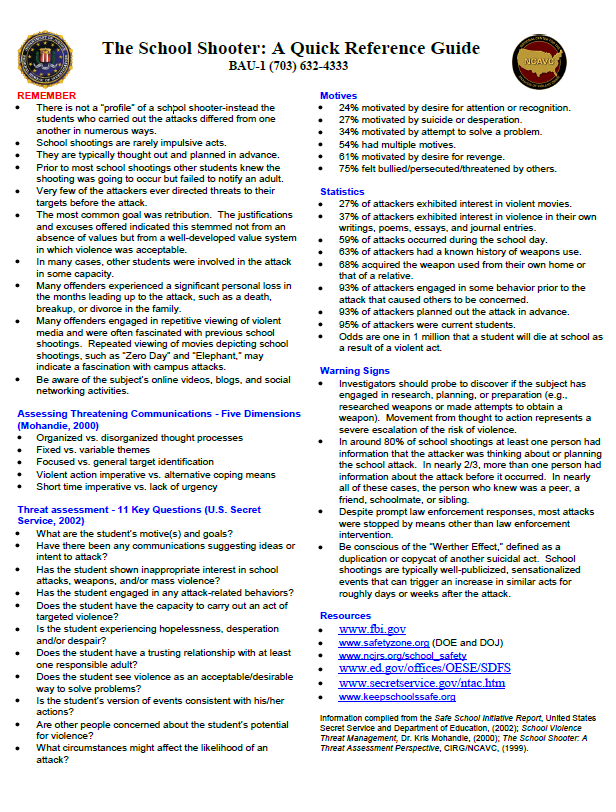 National Center for the Analysis of Violent Crime
National Center for the Analysis of Violent Crime
- 1 page
- April 8, 2009
REMEMBER
- There is not a “profile” of a school shooter-instead the students who carried out the attacks differed from one another in numerous ways.
- School shootings are rarely impulsive acts.
- They are typically thought out and planned in advance.
- Prior to most school shootings other students knew the shooting was going to occur but failed to notify an adult.
- Very few of the attackers ever directed threats to their targets before the attack.
- The most common goal was retribution. The justifications and excuses offered indicated this stemmed not from an absence of values but from a well-developed value system in which violence was acceptable.
- In many cases, other students were involved in the attack in some capacity.
- Many offenders experienced a significant personal loss in the months leading up to the attack, such as a death, breakup, or divorce in the family.
- Many offenders engaged in repetitive viewing of violent media and were often fascinated with previous school shootings. Repeated viewing of movies depicting school shootings, such as “Zero Day” and “Elephant,” may indicate a fascination with campus attacks.
- Be aware of the subject’s online videos, blogs, and social networking activities.
Assessing Threatening Communications – Five Dimensions (Mohandie, 2000)
- Organized vs. disorganized thought processes
- Fixed vs. variable themes
- Focused vs. general target identification
- Violent action imperative vs. alternative coping means
- Short time imperative vs. lack of urgency
Threat assessment – 11 Key Questions (U.S. Secret Service, 2002)
- What are the student’s motive(s) and goals?
- Have there been any communications suggesting ideas or intent to attack?
- Has the student shown inappropriate interest in school attacks, weapons, and/or mass violence?
- Has the student engaged in any attack-related behaviors?
- Does the student have the capacity to carry out an act of targeted violence?
- Is the student experiencing hopelessness, desperation and/or despair?
- Does the student have a trusting relationship with at least one responsible adult?
- Does the student see violence as an acceptable/desirable way to solve problems?
- Is the student’s version of events consistent with his/her actions?
- Are other people concerned about the student’s potential for violence?
- What circumstances might affect the likelihood of an attack?
Motives
- 24% motivated by desire for attention or recognition.
- 27% motivated by suicide or desperation.
- 34% motivated by attempt to solve a problem.
- 54% had multiple motives.
- 61% motivated by desire for revenge.
- 75% felt bullied/persecuted/threatened by others.
Statistics
- 27% of attackers exhibited interest in violent movies.
- 37% of attackers exhibited interest in violence in their own writings, poems, essays, and journal entries.
- 59% of attacks occurred during the school day.
- 63% of attackers had a known history of weapons use.
- 68% acquired the weapon used from their own home or that of a relative.
- 93% of attackers engaged in some behavior prior to the attack that caused others to be concerned.
- 93% of attackers planned out the attack in advance.
- 95% of attackers were current students.
- Odds are one in 1 million that a student will die at school as a result of a violent act.
Warning Signs
- Investigators should probe to discover if the subject has engaged in research, planning, or preparation (e.g., researched weapons or made attempts to obtain a weapon).
- Movement from thought to action represents a severe escalation of the risk of violence.
- In around 80% of school shootings at least one person had information that the attacker was thinking about or planning the school attack. In nearly 2/3, more than one person had information about the attack before it occurred. In nearly all of these cases, the person who knew was a peer, a friend, schoolmate, or sibling.
- Despite prompt law enforcement responses, most attacks were stopped by means other than law enforcement intervention.
- Be conscious of the “Werther Effect,” defined as a duplication or copycat of another suicidal act. School shootings are typically well-publicized, sensationalized events that can trigger an increase in similar acts for roughly days or weeks after the attack.
